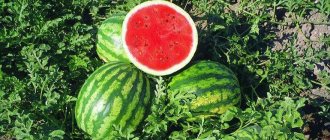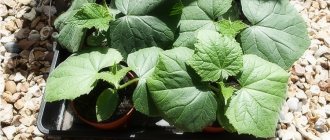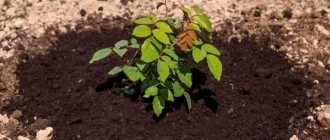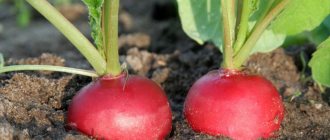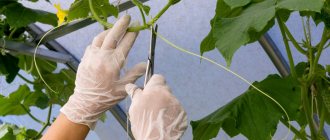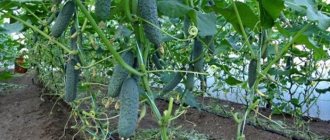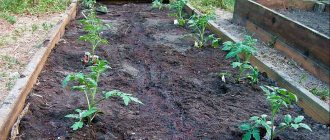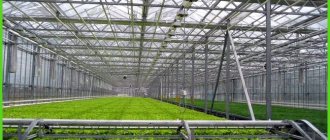How to water eggplants correctly? To answer this question, you need to learn more about what irrigation methods exist and what are the characteristics of soil moisture at different stages of the growing season. You will learn about this, as well as the requirements for the frequency of watering and ways to make the procedure even more beneficial for plants, while reading this article.
How often to water eggplants?
Eggplants do not need too frequent irrigation, as this can lead to changes in the soil structure and the appearance of fungus.
Regularity depends on weather conditions:
- Heat. Repeat the procedure at least once every 3 days.
- Rains. As the earth dries out.
- Neutral climate. You need to add liquid once a week.
There should be about 2 liters of water per plant.
Features of culture
The care and growing conditions required by eggplant are similar in agricultural technology to those needed by sweet peppers. Since these members of the nightshade family come from hot tropical regions, they love high soil moisture. If eggplants do not have enough moisture in the soil, their growth is inhibited, few ovaries appear, and too small fruits are formed.
This plant is overly picky about soil fertility and air permeability, lighting conditions, soil and air humidity.
Watering methods
There are 3 main methods of watering. Each of them has its own advantages and disadvantages.
Using a watering can
It involves manually irrigating plants using a container that usually holds about 10 liters of water. This amount of liquid is enough for 1 square. m of plantings.
What you need to know:
- Plus. Allows you to combine watering with fertilizing. To do this, water is mixed with fertilizers.
- Minus. You have to put in more effort and it takes more time.
It is better to remove the nozzle from the watering can.
Watering with a hose
System requirements:
- Temperature control. Water from an artesian well may be too cold, so it should be discarded.
- Pressure Should be small so as not to damage fragile plants.
- Nozzle. It is better to purchase a sprayer with small holes.
- Way. You cannot direct the flow of liquid to the plants themselves; it is better to take care of irrigating the root zone.
Peculiarities:
- Advantage. Save time, cover a larger area.
- Flaw. The hose may damage the plants. It is recommended to stick glass bottles along the edge of the area, which will serve as limiters.
Drip irrigation system
To do this, you will have to purchase a special tape with holes for water supply. With their help, the liquid reaches directly to the roots of the plants, moistening the soil at a distance of 50 cm and to a depth of 30 cm. The system should be laid between 2 rows of eggplants.
What to pay attention to:
- On a positive note. Watering is virtually effortless. Plants receive moisture at the same frequency and in equal quantities.
- Negative side. Financial investments will be required. But such an installation, if used carefully, can last 4-5 seasons.
Temperature
When caring for eggplants, it is important to monitor not only watering, but also the temperature. This vegetable is heat-loving, so it is very important to create optimal conditions for it.
The best daytime temperature for growing eggplants is 24-28°C, night temperature is not lower than 12-15°C. Vibrations in one direction or the other have a negative effect on the plant.
If the night temperature drops below 12°C, the growth of bushes and fruits, as well as fruit set, slows down. If the daytime temperature exceeds 30°C, then pollination and plant growth stops completely.
Sharp temperature fluctuations are also harmful to eggplants - they can cause the plant to begin to shed flowers and ovaries.
If ventilation alone is not enough to lower the temperature in the greenhouse, then you can try other methods.
- Cover the outside of the greenhouse with any white opaque material or paint it with slaked lime. The white color will reflect the sun's rays and protect the greenhouse from overheating.
- Water the paths in the greenhouse with cold water from a hose from time to time.
To increase the temperature, place hot stones or bricks in the greenhouse. You can use plastic bottles filled with hot water instead. Another method is to fill buckets with hot ash and leave them in the greenhouse overnight.
Watering at different stages of the growing season
Each stage of growth has its own characteristics of soil moisture. It is important to pay attention to them so as not to destroy the plants.
First shoots
Among the main requirements:
- Way. It is carried out at the root of the sprout. In this case, you need to take care of the dryness of the stems and leaves.
- Volume. It is necessary to slightly moisten the soil. Large amounts of liquid can lead to the development of fungal diseases.
- Tools. A watering can is used. With its help, the seedlings are watered very carefully. It is important to prevent damage to plants.
Using glass or transparent film to cover the seedlings will help reduce the need for liquid. It needs to be moved slightly 2 times a day to ensure the flow of oxygen.
After planting the seedlings in a permanent place
Before carrying out the procedure, the beds must be thoroughly moistened. Then watering is carried out regularly until the eggplants take root completely. At this time, the soil should not be allowed to dry out. About 3 liters of water are applied to 1 bush.
Flowering phase
Among the recommendations:
- Temperature. Should be close to the soil in the garden bed.
- Caution. Avoid getting liquid on the ovaries and flowers so that they do not fall off.
- Quantity. Plants require approximately 4-5 liters of water.
Period of fruit formation and growth
To get a good harvest, you need to follow the recommendations:
- Irrigate only in the morning;
- the liquid should moisten the soil to a depth of about 25 cm;
- take care of the correct water temperature;
- apply 4-5 liters per bush.
Loosening and hilling
After watering, a crust forms on the surface of the soil, which prevents air from penetrating to the roots. Lack of oxygen leads to stunted growth of roots and, as a consequence, the entire plant. For this reason, one of the mandatory procedures when growing eggplants is regular (ideally after each watering) loosening.
You need to loosen the soil to a depth of no more than 4-5 cm so as not to touch the roots. This is important because The root system of eggplants is not restored and additional roots, as, for example, on the stems of tomatoes, do not appear.
Simultaneously with loosening, hilling should also be carried out - adding soil to the trunk of the plant.
How to water eggplants correctly?
There are several features of watering this crop:
- Right time. Do not add water during the middle of the day when the sun is shining brightly. As moisture evaporates, the risk of wilting increases. The best period is from morning to lunch, when the heat is not yet so strong.
- Do not wet the leaves. When water gets on the surface of greenery, the risk of developing fungal diseases increases. Therefore, the sprinkling method should be excluded.
- Creating grooves. Make small grooves around the bush, into which you then add water. This has a positive effect on liquid absorption.
You can learn about the main features of proper watering of eggplants while watching the presented video:
There are also differences in watering requirements in different conditions.
In the greenhouse
What information should you learn:
- Way. The drip irrigation method is predominantly used.
- Time. You can add water in the morning or late in the evening.
- Frequency. Selected individually. Usually the same as with standard watering. But if the leaves begin to dry, you should increase the frequency.
- Temperature. It is better to take liquid that has settled for 1-2 days in a greenhouse.
- Humidity. You should avoid high humidity in the room, as this negatively affects the health of the plants. Need to ventilate more often.
In the open ground
The frequency and volume of watering depend on weather conditions. Both soil waterlogging and drying out should not be allowed. Young plants are watered approximately once every 7 days. During the flowering phase, the moisture supply is slightly reduced and increased during fruit ripening.
Preparing the greenhouse for planting
The greenhouse shelter must be completely ready for transplanting seedlings. Its preparation begins in the fall. In all recommendations on how to grow eggplants in a greenhouse made of polycarbonate or other material, it is advised to remove everything from the greenhouse after harvesting. There should be no pegs, benches or other furniture, water barrels, boards or even textile ties left inside the room. All of these are excellent shelters for overwintering pest larvae and pathogenic microflora. Autumn cleaning of the greenhouse will not give them a chance to survive the winter.
In the spring, they begin to disinfect the shelter. To begin with, all surfaces, including the ceiling and walls, are thoroughly washed with laundry soap. If there were outbreaks of infectious diseases last year, disinfection is carried out with a chlorine solution or a steam generator.
In rare cases, the room is disinfected with a sulfur bomb. This is a very effective product, but its use damages the metal parts of the structure. A checker is used if a spider mite is noticed; crops with the same diseases and pests have been grown for several seasons, if insecticides no longer help. Processing is carried out strictly according to the instructions that come with the checker.
When soil is contaminated with pathogenic microflora and to prevent this problem, disinfection is used. They carry it out in different ways. Let's list the simplest methods.
- Heat treatment. The soil mixture is poured with boiling water, hermetically sealed with film, and left for a day.
- Watering with special means. For treatment, biological products such as “Fitosporin” and fungicidal agents such as “Aktara” are used. You can take a 1% aqueous solution of copper sulfate or potassium permanganate.
- Freezing. In autumn, the top soil layer, about 0.3 m high, is removed. The cut soil is placed in small bags and taken outside. In the spring, the substrate disinfected over the winter is poured back into place.
Before planting young plants, the soil mixture in the greenhouse is dug up. For each square meter of digging, add half a bucket of peat, 1 tbsp. spoons of potassium sulfate and 250 g of ash. Heavy clay soils are additionally loosened with sand or humus.
Special watering and fertilizing
There are several recipes that will help moisten the beds and give vegetables the necessary nutrients:
A solution of ammonia. How to cook:
- Take 3 tbsp. l. alcohol
- Pour in 10 liters of water.
- Pour 2-3 liters under the root of each plant.
Tea infusion. Instructions:
- Take a glass of used leaf tea.
- Pour in 5 liters of hot water.
- Leave for 1-2 days.
- Strain.
- Use for root watering.
Herbal feeding. What do you need:
- Collect plantain, wood lice, nettle, dandelion and other herbs.
- Grind thoroughly.
- Fill 1 kg of grass with 10 liters of water.
- Leave for a week until the fermentation process begins.
- Strain.
- Use 500 ml for each bush.
Potassium nitrate. Preparation method:
- Take 30 g of saltpeter.
- Add 10 g of superphosphate.
- Pour in 10 liters of water.
- Mix thoroughly.
- Use 2-3 liters for each plant.
This recipe helps strengthen eggplants and save them from wilting.
Eggshell infusion. The steps are as follows:
- Take shells from 10 eggs.
- Grind thoroughly.
- Pour in 5 liters of heated water.
- Leave for 2 days.
- Strain.
- Pour 1-2 liters per bush.
Water contains calcium, which is necessary for the growth and strengthening of plants.
Forming
Even when choosing low-growing varieties for cultivation, the gardener has to intervene in the formation of bushes:
- All stepsons are plucked from the bottom to the first bud;
- the lower leaves lying on the ground are also cut off;
- to stimulate branching, pinch the crown if a fork does not appear 30-35 cm from the ground;
Tall bushes are tied up like tomatoes to prevent the shoots from falling.
A resident of the Moscow region tells how to remove shoots and maintain the resilience of plants after a stressful intervention in a video on the topic:
How to reduce plants' need for moisture?
There are several secrets that will help reduce the frequency of irrigation:
- Soil selection. It is best to grow eggplants in loose, sandy soils. This will help increase drought tolerance.
- Use of fertilizers. If, after planting, you dig a small ditch around the bush, pour fertilizer into it, and then fill it with water, this will have a positive effect on the development of vegetables and will help retain moisture longer.
- Mulching. The row spacing should be mulched with sawdust or eggshells.
Watering eggplants is not particularly difficult. The main thing is to choose the right method, remember the requirements for water and the frequency of moistening, and use the instructions. Special recipes will help make plants even healthier and stronger. This is the only way to get a really good harvest.
0
0
Copy link
Useful tips
Experts from the field of agricultural technology pay special attention to the problem of watering demanding vegetable crops in greenhouse conditions.
Despite the fact that summer residents adhere to a strict soil moisture scheme, there is a list of factors that affect the frequency of watering:
- climatic conditions within a specific region;
- plant variety;
- eggplant age;
- acidity and soil composition.
It is necessary to maintain a golden mean. Excess dampness will lead to rotting of the root system and the death of your plant. A deficiency will cause a poor harvest. The soil in which eggplants grow should always be moderately moist.
The plant has heavy pollen. Due to this, it is difficult for the vegetable to pollinate on its own in conditions of high humidity. Some vegetable growers advise specifically shaking the plant during flowering or spreading pollen using a brush.
Groundbaits
Basic care of plants in a greenhouse includes periodic addition of bait. During the season, fertilizing is added no more than four times, taking into account the condition of the bushes.
The first feeding is carried out a couple of weeks after planting the seedlings. This period is given to seedlings for survival and adaptation.
During the growing season and until the time of fruit formation, plants are fed with macro- and microelements. What is Mortar used for? For one bucket of water, one tbsp. l. drug. During fruiting, eggplants are fed with preparations that contain nitrogen and phosphorus. Add one tbsp to one bucket of water. l. superphosphate and nitrate. But you should not overdo it, as organic matter can negatively affect the growth of eggplants. To avoid this, organic matter is alternated with mineral fertilizers. This is the best option for feeding plants.
During eggplant ripening, the beds are sprinkled with ash. Towards the end of this time, add potassium sulfate - 1 tsp. drug into a bucket.
Growing seedlings from seeds to seedlings
You can, of course, buy ready-made seedlings and plant them, but many gardeners prefer to grow young blue ones from seeds themselves. By following a few simple rules, you can easily grow seedlings for planting in a polycarbonate greenhouse:
- Seed preparation.
Preparation includes awakening the seeds, their disinfection and hardening. Warm water will help awaken the seeds, disinfect a 1 percent solution of potassium permanganate, and you can harden them in the refrigerator by placing the prepared seeds in it for 48 hours; - Soil preparation.
The soil for eggplants must be neutral in acidity and disinfected from fungi and pests. A suitable mixture is one to one peat and turf soil and a little sand; - The soil is placed in a grid with nests and slightly moistened.
Afterwards, the seeds are sown, 2 seeds per hole, to a depth of 1 to 2 cm; - Grown seedlings should be replanted when they have a sufficiently developed root system, a stem height of 20 cm and at least 8 leaves. This usually occurs at 75 days of age.

